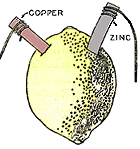


 It is possible to get electricity from a lemon (and a few other acidic fruits and vegetables) using two strips of metal. The most readily available combination is copper and zinc. The zinc piece can be taken from the casing of an old carbon "D" cell (battery); some zinc coated nails may work as well. The copper can be a coin containing a high amount of copper. (Note: some recent copper coins, including the newer U.S. pennies, contain low amounts of copper mixed with zinc. If in doubt, use a pure copper strip.) They are stuck into the lemon, and wires are attached to each one. The wires should be attached securely to form a good electrical contact. If the other ends of the wires are attached to a small light bulb (flashlight bulb) there should be sufficient current to light it. Note that the metal pieces should be clean, and that they should not touch inside the lemon.
It is possible to get electricity from a lemon (and a few other acidic fruits and vegetables) using two strips of metal. The most readily available combination is copper and zinc. The zinc piece can be taken from the casing of an old carbon "D" cell (battery); some zinc coated nails may work as well. The copper can be a coin containing a high amount of copper. (Note: some recent copper coins, including the newer U.S. pennies, contain low amounts of copper mixed with zinc. If in doubt, use a pure copper strip.) They are stuck into the lemon, and wires are attached to each one. The wires should be attached securely to form a good electrical contact. If the other ends of the wires are attached to a small light bulb (flashlight bulb) there should be sufficient current to light it. Note that the metal pieces should be clean, and that they should not touch inside the lemon.
The electric current comes from the chemical reaction between the acid in the lemon and the zinc. Positively charged hydrogen in the acid oxidizes the zinc, causing electrons to flow from the zinc to the acid. In the process, some of the hydrogen in the acid is reduced to hydrogen gas.The copper merely completes the circuit.
Judging by my e-mail, even though this project is very simple, it is especially difficult to get working. Keep in mind that one or even several lemons in series produce only a tiny amount of voltage. The amount is unpredictable and dependent on many factors, including the acidity of the lemon and the metals used. One lemon should light a tiny bulb, but then again it may not. Try testing with a voltmeter. If the meter swings a tiny bit, you know that it is working. Wiring several lemons in series (bulb-copper-lemon-zinc-connecting wire-copper-lemon-zinc-bulb) may do the trick. If you can't get a light bulb to work, try improvising a galvanometer to show the voltage. Do this by wrapping about ten turns of thin wire (insulated) around a small magnetic compass to form a coil. Strip the free ends of the wire and touch them to the zinc and copper strips in the lemon. The current should be enough to set up a small magnetic field in the coil, causing the compass needle to divert.
A few people have also told me that they have had more success lighting an LED. Remember that an LED will only work with the current flowing the right way through it, so if it doesn't work at first try switching the leads.

This article was printed from the Bizarre Labs website at bizarrelabs.com